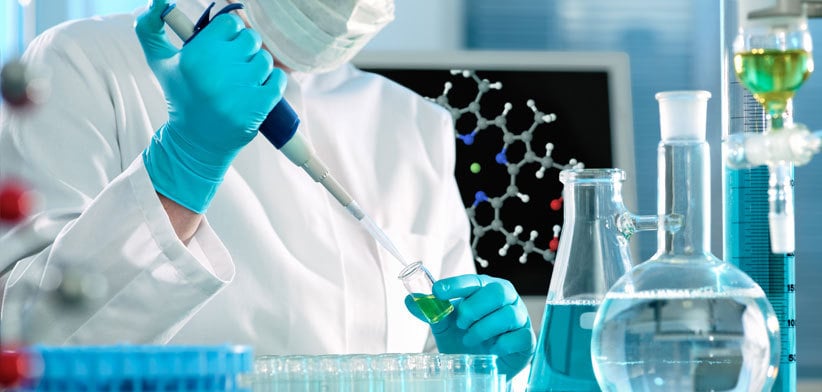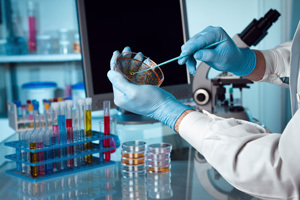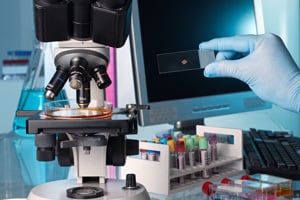47 Carrington Road
Marrickville NSW 2204
 Services
Preservative Efficacy Testing
Services
Preservative Efficacy Testing
Preservative Efficacy Testing

The Low-Down on Micro Reporting
Preservative Efficacy Testing
This is a microbiological test of your product to see how the preservative system copes when challenged by microbes over one month.
What happens during testing?
Microbes of known type and concentration are added to your product at days 0, 2, 7, 14 and 28. We watch to see what happens to them to work out if your preservative system is working.
What units of measure are used?
The numbers on the report refer either to Colony Forming Units per gram of product (cfu/g) or probably number per gram (PN/g). It is possible to have hundreds of thousands of microbes per gram of product, as these microbes are so tiny. However, we want way less than that!
What is a good result?
All test protocols require that microbes do not grow in the formula with most test protocols requiring that the number of CFU/g falls over the test protocol. The results below show a pass for the British Pharmacopeia standard as the preservative was able to reduce the number of CUF's over time.
The numbers on the report refer either to Colony Forming Units per gram of product (cfu/g) or probably number per gram (PN/g). It is possible to have hundreds of thousands of microbes per gram of product, as these microbes are so tiny. However, we want way less than that!
What is a good result?
All test protocols require that microbes do not grow in the formula with most test protocols requiring that the number of CFU/g falls over the test protocol. The results below show a pass for the British Pharmacopeia standard as the preservative was able to reduce the number of CUF's over time.

Enterobacteriaceae: These are a family of gram-negative bacteria that include salmonella and E Coli, neither of which are permitted within cosmetic products. These microbes ferment sugar to form lactic acid when growing which can lead to a drop in your product pH over time.This family of microbes can enter into your cosmetics through dirty hands either during processing or ingredient picking or in-use.
A Brasiliensis: This is the new name for Aspergillus Niger. It is the traditional black mould fungus that you may have seen on cosmetic jar products before. It is commonly found contaminating food as it is ubiquitous (found everywhere) and eventually colonises damp, nutrient rich surfaces such as open jars of cream or over-ripe fruit in a bowl! This is a common issue in clay containing formulations.
C. Albicans: Candida Albicans is a fungus that is usually found on the skin and as such is quite a common contaminant in cosmetics. It can cause fungal nail infections and other skin rashes when out of balance.
P.Aeruginosa: This is another gram-negative bacteria and one that is found living on our skin as well as in the soil and on many solid surfaces. These form slimes and foul odours when present in cosmetics so are very rarely missed! It usually appears due to contaminated materials and an overwhelmed preservative system. In cosmetics this can cause serious health issues including permanent loss of sight when present in eye products.
S.Aureus: This is sometimes called Golden Staph. It is a common gram-positive bacteria that lives on the skin or in the nose making it a potential skin care contaminant. It can also be found in our respiratory tract, which is why we should wear facemasks when mixing and pouring cosmetic products. In terms of cosmetic product contamination this is one microbe that is likely to cause skin infections such as boils, pimples and soreness so best avoided unless you want some very angry and infected clients on your doorstep!


How much does the test cost?
It will cost $1,155 (GST inclusive) to have this test carried out on your sample. The test is quite expensive to run as the samples have to be prepared and tested five times during the test protocol and your test sample has to be prepared also to ensure accurate results.
What does the test show?
If all goes well the test should show you that the preservative system is both present and actively defending the product against these commonly found microbes.
It will cost $1,155 (GST inclusive) to have this test carried out on your sample. The test is quite expensive to run as the samples have to be prepared and tested five times during the test protocol and your test sample has to be prepared also to ensure accurate results.
What does the test show?
If all goes well the test should show you that the preservative system is both present and actively defending the product against these commonly found microbes.
What doesn't it show?
As the test is usually carried out on a fresh batch of product the test won't tell you how well the preservative stands up to time. It may be that after six to twelve months of actively defending your product the preservative is used up and no longer works. That could only be determined via stability testing and further PET further down the products shelf life. The testing also only shows results for the microbes that you test for and while these are the most important in terms of cosmetic contamination there are many, many more microbes that could be present but aren't showing. It isn't practical to test for everything but in some cases you may need to add other microbes to your protocol!
Which products need PET? All leave-on products, eye products, baby care, products for extra dry or damaged skin and many more. If in doubt, consult your manufacturer, formulator or testing house.
Can I test my own samples?
Not really. Unless you are a qualified microbiologist with access to a NATA accredited lab it isn't advisable to test your own products. It may save money but intentionally growing pathogenic microbes is not something that many people would want to handle. Best left to the experts who have the validated test methods to back up their results.
Can I do one test per range or does every product need testing?
There may sometimes be a case for testing one product in a range (colour shades for example) rather than each one but this should be discussed on a case-by-case basis with the micro test facility and cross-checked with the regulations for your target market.
How long are the results valid for?
The results are valid for as long as you maintain that formula. That may be 1 year or 20 years. If you make any changes to the structure of the formula you will need to re-test. This includes changing fragrance, colour or concentration of any other ingredient. For this reason it is best to do your testing when you are sure that your formula is right.
What does a micro count look like?
Below are the results for a basic micro count. This is the simplest micro test on offer and just gives you an idea of how clean the product is without delving into the detail of what each microbe is. As this product came back with less than 100 colony-forming units per gram it passed the test and can be used as a cosmetic.

A second type of micro count is shown below where we have looked at Aerobic bacteria and Lactic acid producing bacteria. It is important to discuss your micro concerns with the laboratory to work out what testing is best for you. This is especially important when trying to isolate and identify a problem or implement a solution to a current problem.

Here is a result on a water sample. As you can see a fair bit more testing is involved here as water goes into all products and contamination here will spill over into everything that is made on the plant.

How do I know what test I should do on my product?
The cosmetics industry has been micro testing products for many years and has a series of standard tests that you can use to get you started. Beyond that it may be worth talking to your micro laboratory (there are micro facilities all over the country as they have to test food, drink and medicines) about the specifics of your formulations - packaging, novel ingredients, stability etc. to see if they can help you develop a protocol to give you peace of mind.
What does the government say about testing products?
The Australian government doesn't specify how you should test your products, only that cosmetics should be fit for use and safe. Your micro testing results will help you to prove that you have carried out your due diligence and placed a microbiologically safe product on the market (to the best of your knowledge).That falls within your responsibility as a brand owner.
The Australian government doesn't specify how you should test your products, only that cosmetics should be fit for use and safe. Your micro testing results will help you to prove that you have carried out your due diligence and placed a microbiologically safe product on the market (to the best of your knowledge).That falls within your responsibility as a brand owner.

How do I have my products tested?
New Directions Australia can send your products for testing to an external lab, at a charge of $1,155 (GST inclusive) per product. We will require 500g of samples to send for testing, preferably in your end user packaging.The test takes between 8 - 10 weeks.
